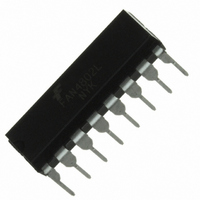FAN4802LNY Fairchild Semiconductor, FAN4802LNY Datasheet - Page 20

FAN4802LNY
Manufacturer Part Number
FAN4802LNY
Description
IC PFC CTRLR AVERAGE CURR 16DIP
Manufacturer
Fairchild Semiconductor
Specifications of FAN4802LNY
Mode
Average Current
Frequency - Switching
64kHz
Current - Startup
30µA
Voltage - Supply
11 V ~ 22 V
Operating Temperature
-40°C ~ 105°C
Mounting Type
Through Hole
Package / Case
16-DIP (0.300", 7.62mm)
Operating Temperature (max)
105C
Operating Temperature (min)
-40C
Pin Count
16
Mounting
Through Hole
Screening Level
Industrial
Lead Free Status / RoHS Status
Lead free / RoHS Compliant
© 2008 Fairchild Semiconductor Corporation
FAN4800A/C, FAN4801/02/02L • Rev. 1.0.3
Two-Level PFC Function
To improve the efficiency, the system can reduce PFC
switching loss at low line and light load by reducing the
PFC output voltage. The two-level PFC output of
FAN4801/02/02L can be programmable.
As Figure 47 shows, FAN4801/02/02L detect VEA pin
and VRMS pin to determine the system operates low
line and light load or not. At the second-level PFC, there
is a current of 20µA through R
the second-level PFC output voltage can be calculated
as.
For example, if the second-level PFC output voltage is
expected as 300V and normal voltage is 387V,
according to the equation, R
The programmable range of second level PFC output
voltage is 340V ~ 300V.
Oscillator (R
The oscillator frequency is determined by the values of
R
the oscillator output clock:
The dead time of the oscillator is derived from the
following equation:
at V
The dead time of the oscillator is determined using:
The dead time is so small (t
operating frequency can typically be approximated by:
Output
T
f
t
t
f
RT CT
RT CT
DEAD
RT CT
and C
REF
/
/
/
=7.5V and t
Figure 47. Two-Level PFC Scheme
T
7.78
R
, which determine the ramp and off-time of
C
t
t
2.8
RT CT
RT CT
F
T
1
R
1
V
mA
/
/
F
T
R
R
2
/C
T
F
1
RT/CT
2
T
C
t
ln
)
DEAD
T
(2.5
=CT x RT x 0.56.
VREF
VREF
360
V
F2
20
is 28kΩ R
C
F2
3.8
T
uA R
RT/CT
1
from FBPFC pin. So
>>t
F
F1
2
DEAD
)
is 4.3MΩ.
) that the
(4)
(5)
(6)
(7)
(3)
20
Pulse Width Modulator (PWM)
The operation of the PWM section is straightforward,
but there are several points that should be noted.
Foremost among these is the inherent synchronization
of PWM with the PFC section of the device, from which
it also derives its basic timing. The PWM is capable of
current-mode or voltage-mode operation. In current-
mode applications, the PWM ramp (RAMP) is usually
derived directly from a current sensing resistor or
current transformer in the primary of the output stage. It
is thereby representative of the current flowing in the
converter’s output stage. I
cycle current limiting, is typically connected to RAMP in
such applications. For voltage-mode operation and
certain
connected to a separate RC timing network to generate
a voltage ramp against which FBPWM is compared.
Under these conditions, the use of voltage feed-forward
from the PFC bus can assist in line regulation accuracy
and response. As in current-mode operation, the I
input is used for output stage over-current protection.
No voltage error amplifier is included in the PWM stage,
as this function is generally performed on the output
side of the PWM’s isolation boundary. To facilitate the
design of opto-coupler feedback circuitry, an offset has
been built into the PWM’s RAMP input that allows
FBPWM to command a 0% duty cycle for input voltages
below typical 1.5V.
PWM Cycle-By-Cycle Current Limiter
The ILIMIT pin is a direct input to the cycle-by-cycle
current limiter for the PWM section. Should the input
voltage at this pin ever exceed 1V, the output flip-flop is
reset by the clock pulse at the start of the next PWM
power cycle. When the I
bi-cycle current, it limits the PWM duty cycle mode and
the power dissipation is reduced during the dead-short
condition.
V
The V
PFC and inhibits the PWM if the voltage on FBPFC is
less than its nominal 2.4V. Once the voltage reaches
2.4V, which corresponds to the PFC output capacitor
being charged to its rated boost voltage, the soft-start
begins.
PWM Soft-Start (SS)
PWM startup is controlled by selection of the external
capacitor at soft-start. A current source of 10µA
supplies the charging current for the capacitor and
startup of the PWM begins at 1.5V.
IN
OK Comparator
IN
OK comparator monitors the DC output of the
specialized
applications,
LIMIT
LIMIT
triggers the cycle-by-cycle
, which provides cycle-by-
RAMP
www.fairchildsemi.com
can
LIMIT
be











